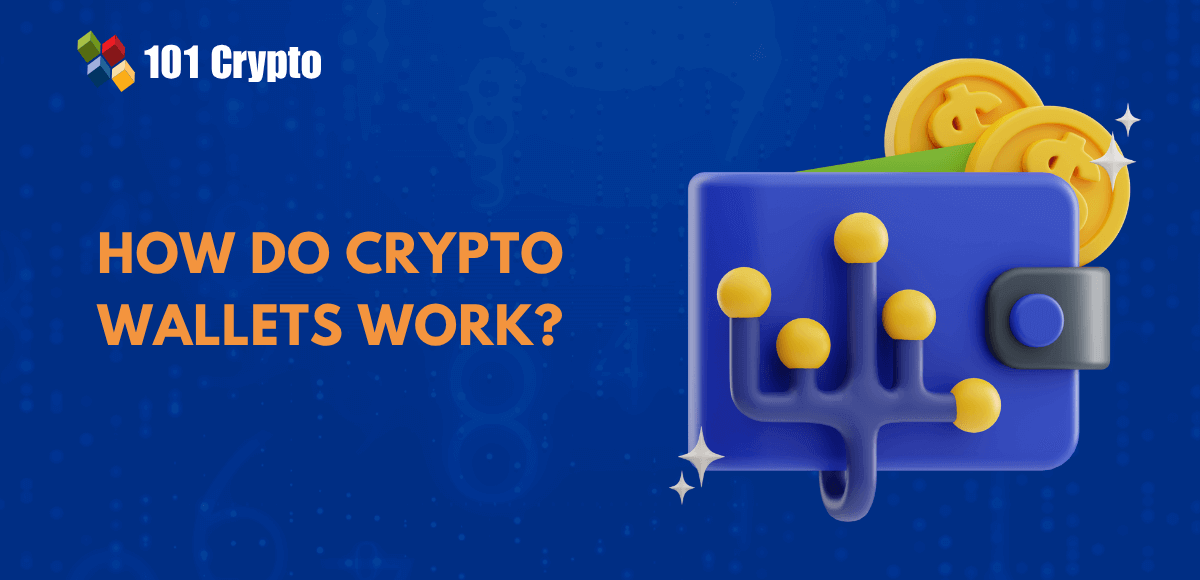Diving into the cryptocurrency landscape can be significantly challenging for beginners, especially with the confusion due to unfamiliar concepts and terms. One of the most notable things that you will need to interact with the crypto space is a crypto wallet. You might think that a crypto wallet works like a physical wallet in a digital form albeit for storing cryptocurrencies. Contrary to the general assumptions about crypto wallets, they work in a completely different way.
Any beginner in the world of crypto must know that crypto wallets are essential for secure management of your digital assets. Let us learn more about the working of crypto wallet with attention to their different underlying components.
Enroll now in the Bitcoin Fundamentals Free Course to gain deep insights on how the Bitcoin blockchain works.
Understanding a Crypto Wallet
The first thing that you must learn before searching for how crypto wallets work is the definition of a crypto wallet. The most common misconception about crypto wallets is that they store cryptocurrencies like a physical wallet holds cash and coins. You must know that a crypto wallet does not store your digital currency. On the contrary, your cryptocurrencies exist on a distributed public ledger or blockchain, which is a massive record book maintaining the records of every crypto transaction.
Crypto wallets are program or applications that help you interact with the blockchain to gain access and manage crypto assets. The working of a crypto wallet app focuses primarily on the private key and public key. The public and private keys help in proving ownership of your crypto assets and authorizing transactions. You can get a better understanding of the working of crypto wallets by learning about the utility of public and private keys.
-
Private Keys in Crypto Wallets
Private keys are similar to the password for your bank account or the PIN for your debit card. Only you know them and if anyone else knows them, then they also have access to your money. In the case of crypto wallets, the private key is an incredibly long and unique password. Users should never disclose their private keys to anyone as it means handing over the custody of your crypto assets. The private key looks like a string of numbers and alphabets, which serves as the master key to your crypto assets.
The private key proves that you are the true owner of your crypto assets. Private keys are also important for the use of crypto wallet to send crypto as they help in authorization. Crypto wallets rely on private keys for signing transactions as they prove that you are authorizing the fund transfer. Users must safeguard their private keys as they hold the privilege of access to your crypto assets in the wallet.
-
Public Keys in Crypto Wallets
If private keys serve as the password to your crypto wallet, the public key represents the address or unique identifier of your wallet. It is interesting to note that your crypto wallet will generate the private key and public key for your wallet during the setup phase. The public key is also a long string of numbers and alphabets although it can be shared unlike the private key. You can share the public key with anyone when you want to receive cryptocurrency.
The public key is like the wallet address, which shows that you own the wallet, without revealing your identity. Anyone can see the transactions happening on the wallet address albeit without any clue about the owner of the address. Another important aspect about the public key is that it is derived from the private key. Interestingly, it is not possible to reconstruct the private key from the public key or your wallet address.
Primary Functions of a Crypto Wallet
The primary functions of a crypto wallet include generating key pairs, facilitating transactions, storing private keys and displaying account balance. Crypto wallets generate a unique pair of public and private keys when you create a new wallet. The wallet also uses the private key for digitally signing crypto transactions when you want to send crypto. In addition, the wallet also broadcasts the transaction to the blockchain for verification and addition to a block.
The most important function of a crypto wallet is the secure storage of private keys. On top of it, crypto wallets can also help in reading the blockchain to find out your current crypto balance on different public addresses. It is similar to checking your bank statement to find your account balance.
Unraveling the Different Variants of Crypto Wallets
The next important highlight in a guide on the working of cryptocurrency wallets is the outline of different variants. The types of crypto wallet that you can find in the existing crypto landscape include hot wallets and cold wallets. You must understand the difference between hot and cold wallets to understand which one is the best for security or convenience. Let us take a look at how the two popular variants of crypto wallets work.
-
Hot Wallets
Hot wallets have earned their name for being actively connected to the internet. You can trust hot wallets for convenience and ease of use albeit with higher security risks from online exposure. The notable types of hot wallets include exchange wallets, desktop wallets and mobile wallets. Cryptocurrency exchanges like Coinbase and Binance provide hot wallets albeit while keeping your private keys in their custody.
Desktop and mobile wallets are the best examples of hot wallets installed as applications on your computers or smartphones. You can use desktop or mobile wallets if you want more control over your private keys. At the same time, desktop and mobile wallets are vulnerable to problems associated with the devices.
Even if hot wallets provide convenience, the constant connection to the internet makes them easy targets for online threats. You should trust hot wallets for smaller amounts of crypto assets that you want to use for everyday transactions or trading.
-
Cold Wallets
Cold wallets are the next important category of crypto wallets that have gained popularity among users. The answers to “How does a crypto hardware wallet work?” will draw attention towards cold wallets as hardware wallets are the best examples of cold wallets. Hardware wallets look like USB drives and help in storing your private keys without online exposure. The assurance of better security with hardware wallets has made them the top choices for crypto security.
Hardware wallets work by connecting to a computer or smartphone to initiate the transaction. However, the transaction signing happens completely in the hardware wallet, thereby safeguarding the private key from online exposure. As a result, hardware wallets are more immune to online hacks and offer complete control over your private keys. On the contrary, you cannot use hardware wallets frequently for trading or everyday transactions.
Another prominent example of a cold wallet is a paper wallet. There is nothing special about a paper wallet as you can create one by writing down your public key, private key and seed phrase on a paper. The biggest problem with paper wallets is the vulnerability to physical damage, theft and loss. While a hardware wallet is an ideal choice for long-term storage of large amounts of crypto, paper wallets may be a risky option.
Significance of the Seed Phrase
You cannot complete a discussion about the working mechanism of crypto wallets without focusing on the seed phrase. Non-custodial wallets that require users to control their private keys will provide a seed phrase, which is a sequence of words. The seed phrase is a human-readable version of your private key and has a direct link to the private keys.
If you lose your wallet device, private keys or your computer breaks down, the seed phrase serves as the backup. The seed phrase is also called as recovery phrase because it can help you restore access to all your crypto assets in a new device or app. Therefore, the security of your seed phrase deserves the most attention as it holds the key to your crypto treasure.
Flow of a Transaction in Crypto Wallets
The most useful highlight to understand how a crypto wallet works is an overview of the flow of a transaction. Users can open their wallet app and initiate the transaction by adding the public wallet address of the recipient. The wallet bundles the transaction details and prepares for the transaction signing.
In the case of hot wallets, transaction signing happens in the software of the wallet app. On the other hand, hardware wallets sign the transaction in the offline environment. After successfully signing the transactions, the wallet will broadcast the transaction to the blockchain network of the corresponding crypto asset.
Final Thoughts
The functionality of a crypto wallet app depends on the combination of public and private keys. You can find two different types of wallets for cryptocurrencies, such as hot wallets and cold wallets. The primary difference between hot wallet and cold wallets is the requirement of active internet connectivity. Hot wallets are always connected to the internet while cold wallets never expose your private keys online. Crypto wallets work by generating a unique pair of public and private keys along with the seed phrase or recovery phrase. Learn more about the utility of cryptocurrency wallets and their benefits now.
Disclaimer
The article should not be taken as, and is not intended to provide any investment advice. Claims made in this article do not constitute investment advice and should not be taken as such. 101 Crypto shall not be responsible for any loss sustained by any person who relies on this article. Do your own research!







